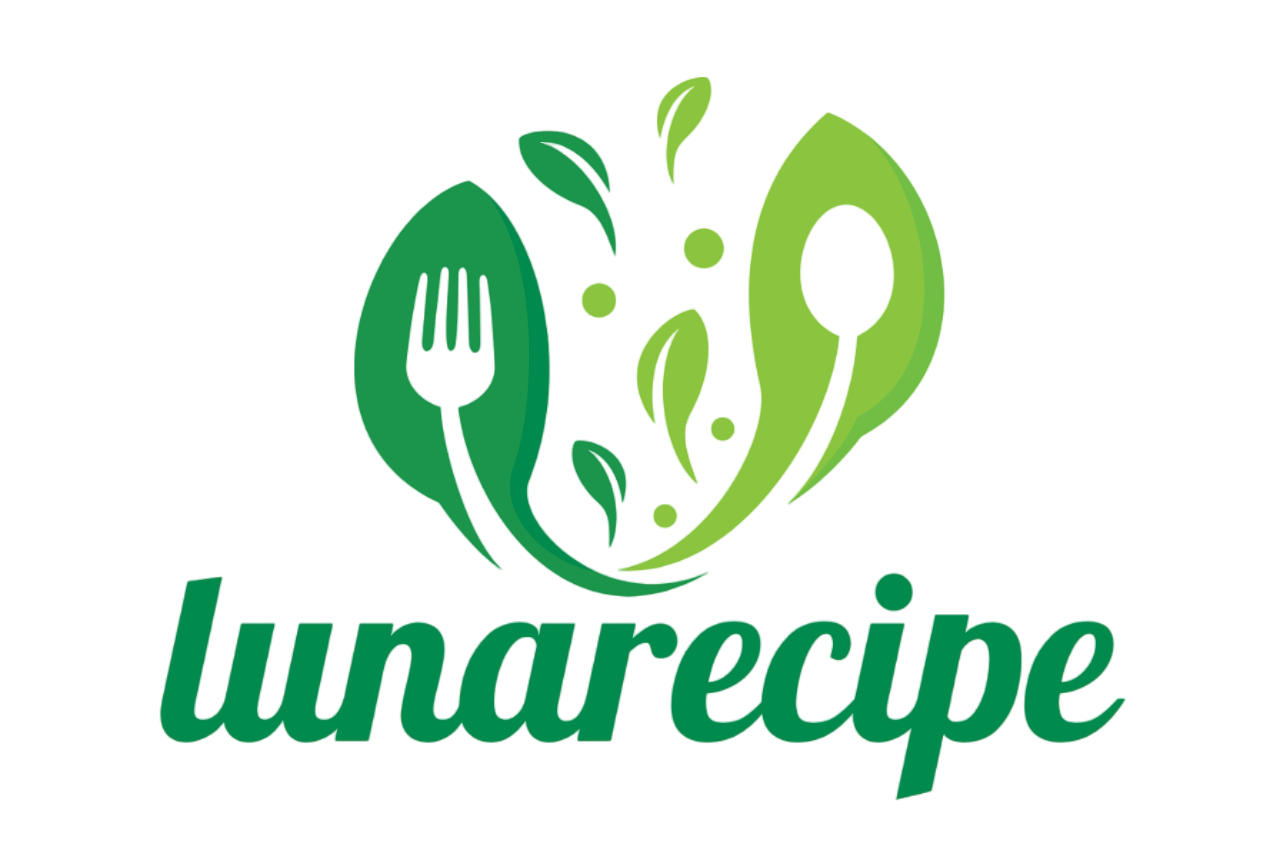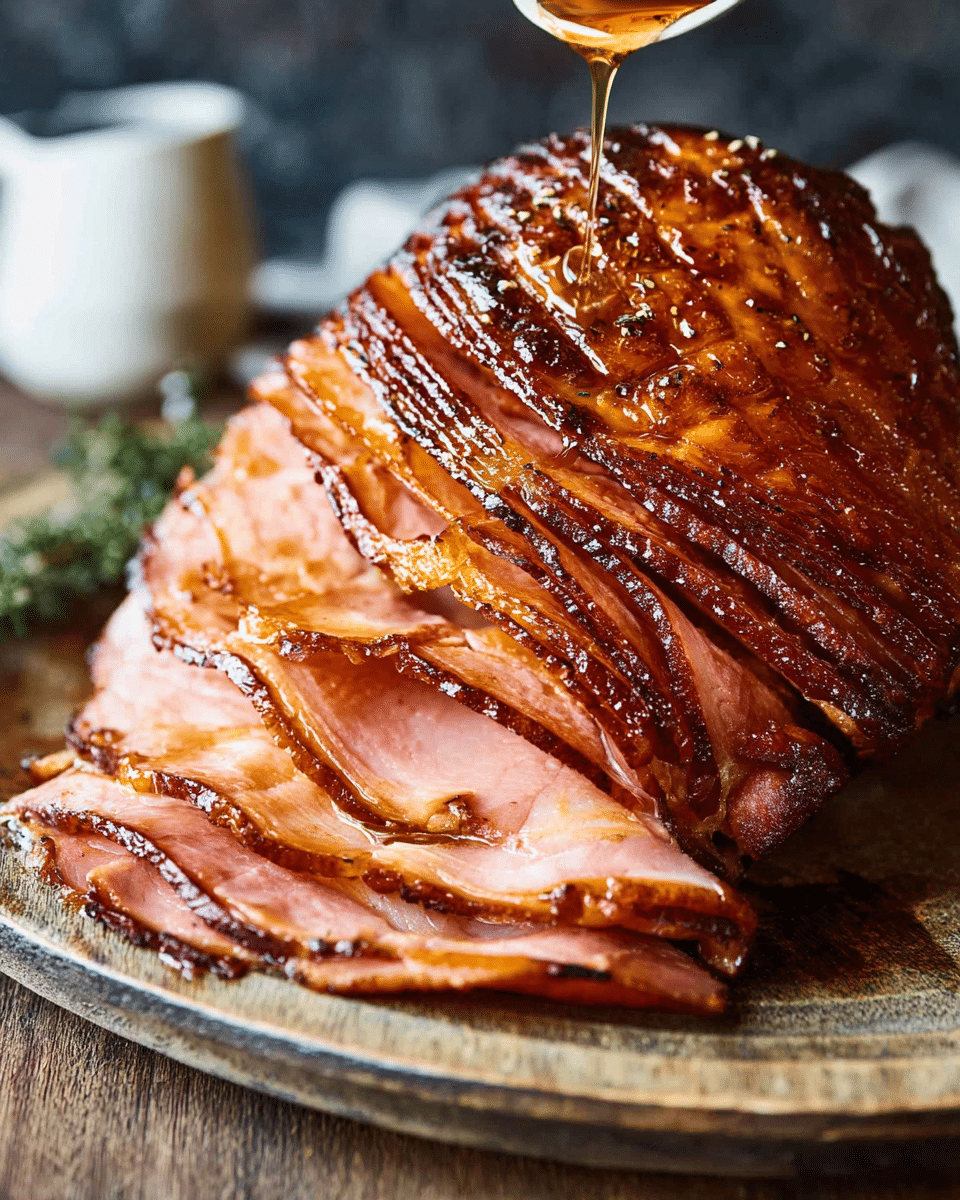This Honey Baked Ham is the ultimate centerpiece for any holiday meal, offering a perfect balance of sweet, savory, and slightly spicy flavors. The honey glaze forms a beautiful caramelized crust that enhances the richness of the ham, making each slice more delicious than the last. Whether you’re celebrating Christmas, Easter, or a family gathering, this ham recipe will quickly become a tradition. It pairs wonderfully with roasted vegetables, mashed potatoes, or a simple salad, making it versatile enough for any occasion. Easy to make yet incredibly impressive, this dish is sure to satisfy a crowd.
Full Recipe:
-
1 spiral-cut ham (about 6-8 pounds)
-
1 cup honey
-
1/2 cup brown sugar
-
1/4 cup Dijon mustard
-
1/4 cup apple cider vinegar
-
1/4 teaspoon ground cloves
-
1/4 teaspoon ground cinnamon
-
1/4 teaspoon ground ginger
-
1/4 teaspoon salt
-
1/4 teaspoon black pepper
-
1/4 cup water
Directions:
-
Preheat your oven to 325°F (165°C).
-
Place the ham, flat side down, on a roasting rack inside a large roasting pan.
-
In a small saucepan, combine the honey, brown sugar, Dijon mustard, apple cider vinegar, ground cloves, cinnamon, ginger, salt, and black pepper. Heat over medium heat, stirring occasionally, until the mixture is smooth and well combined (about 5 minutes).
-
Pour the honey glaze over the ham, ensuring it is generously coated. Cover the ham loosely with aluminum foil.
-
Bake in the preheated oven for 1.5 to 2 hours, basting the ham with the glaze every 30 minutes.
-
After the baking time, remove the foil and increase the oven temperature to 425°F (220°C). Continue baking for an additional 15-20 minutes, or until the ham is caramelized and browned.
-
Let the ham rest for 10-15 minutes before slicing and serving.
Prep Time: 10 minutes | Cooking Time: 2 hours | Total Time: 2 hours 10 minutes
Kcal: 380 kcal | Servings: 12 servings
History and Origin
The origins of honey baked ham can be traced back to ancient cooking methods, where people would slow-cook ham over an open flame or in ovens. While the exact historical origin of the honey glaze itself is unclear, the combination of sweet and savory flavors is believed to be influenced by the culinary traditions of various cultures. In Europe, glazed hams were often made with fruit preserves or syrups, and this concept slowly spread across different cuisines.
Honey has long been used as a sweetener, and in many cultures, it’s viewed as a symbol of prosperity, abundance, and good fortune. It’s no wonder then that honey became a go-to ingredient for glazes meant to enhance rich meats like ham. The trend of “honey baked ham” in its modern form gained popularity in the United States, where it became a staple for special occasions. In particular, the recipe flourished in Southern cuisine, where ham is often the main dish at family gatherings and holidays. The slow roasting of ham, coupled with a honey glaze, gave rise to a dish that celebrates both the savory and sweet traditions of American cooking.
Variations and Adaptations
While the classic honey baked ham is universally loved, there are several variations that can elevate this dish or make it fit different regional tastes.
-
Spicy Honey Baked Ham: Some recipes incorporate chili flakes, Dijon mustard, or hot sauce into the glaze to add a kick. This spicy-sweet combo adds an unexpected depth of flavor that is especially popular in Southern and Cajun cooking.
-
Apple or Pineapple Glaze: While honey remains the star ingredient, many versions of honey baked ham use fruit juices or even fruit preserves to add a refreshing twist. Pineapple and apple juice, in particular, pair wonderfully with the sweetness of honey and provide a tangy counterpoint to the richness of the ham.
-
Maple Glaze Alternative: For those who prefer a different type of sweetness, maple syrup can be used in place of honey. This adaptation gives the ham a slightly different flavor profile—earthier and deeper in taste—while still maintaining the glossy caramelization.
-
Herb-Infused Glaze: For a more complex flavor, fresh herbs like rosemary, thyme, or sage can be added to the glaze. These herbs balance the sweetness of the honey and give the dish an aromatic, savory touch.
-
Smoked Ham: While traditional honey baked ham uses a regular spiral-cut ham, smoked ham brings an additional layer of smokiness, which can complement the sweet glaze. The contrast of flavors is particularly enjoyable for those who love a bold, smoky taste.
-
Gluten-Free Options: If you need to accommodate gluten-free guests, it’s easy to make a gluten-free honey baked ham by ensuring that all ingredients in the glaze are certified gluten-free. You can also add a little cornstarch or potato starch to the glaze to thicken it without any wheat-based flour.
Nutritional Information
Honey baked ham is not only a delicious indulgence but can also be a relatively nutritious option when consumed in moderation. It’s an excellent source of protein, offering around 20-25 grams per 3-ounce serving. However, ham is also quite high in sodium, so it’s important to be mindful of portion sizes, especially for those on low-sodium diets.
Here’s a breakdown of the nutritional components for a standard serving of honey baked ham (approximately 3 ounces):
-
Calories: 300–350 kcal
-
Protein: 20–25 grams
-
Total Fat: 15–20 grams
-
Saturated Fat: 5–7 grams
-
Cholesterol: 40–50 mg
-
Sodium: 800–1,200 mg (varies based on the ham’s salt content)
-
Carbohydrates: 25–30 grams
-
Sugars: 20–25 grams (mainly from the honey and glaze)
Although the honey glaze adds a bit of sugar, it’s still a healthier alternative to many other glazes that rely on refined sugars. It’s also a good source of several important micronutrients, including B vitamins (especially niacin and riboflavin) and minerals like phosphorus and selenium. To make it even healthier, consider pairing it with roasted vegetables or a green salad to balance the rich flavors.
Serving Suggestions and Pairings
Honey baked ham is incredibly versatile when it comes to side dishes and pairings. Its richness and sweetness lend themselves well to a variety of accompaniments.
-
Mashed Potatoes: A classic side, creamy mashed potatoes are the perfect contrast to the salty, sweet ham. You can opt for traditional mashed potatoes, or switch it up with mashed sweet potatoes for an added touch of sweetness.
-
Roasted Vegetables: Roasted Brussels sprouts, carrots, or green beans are excellent choices. Their slightly charred and caramelized exterior pairs perfectly with the sweet honey glaze on the ham.
-
Cranberry Sauce: The tartness of cranberry sauce is a wonderful complement to the richness of the ham. It adds a refreshing contrast, both in flavor and color.
-
Dinner Rolls or Biscuits: Soft, pillowy rolls or buttery biscuits are ideal for soaking up any extra glaze that might be left on the plate. The combination of the warm bread and sweet ham is a real crowd-pleaser.
-
Wine Pairing: To balance the richness of the ham, a slightly fruity wine such as a Pinot Noir or a light Riesling can work beautifully. For something a little more decadent, try a full-bodied Chardonnay, which can complement both the ham and any cream-based side dishes.
-
Salad: A fresh green salad with a tangy vinaigrette can help cut through the richness of the ham and provide a refreshing counterpoint to the heaviness of the main dish.
Tips and Tricks for Success
-
Slow Cooking is Key: Make sure to bake your honey glazed ham slowly to allow the glaze to develop its caramelized flavor. High heat can cause the sugar to burn, so avoid rushing the process.
-
Baste Regularly: For the best results, baste your ham every 30 minutes with the glaze. This ensures the flavor seeps into the meat, creating that perfectly sweet and savory balance.
-
Use a Roasting Rack: Placing your ham on a roasting rack helps to ensure even cooking and prevents the bottom of the ham from becoming too soggy. It also allows air to circulate around the ham for a more even glaze.
-
Rest Before Serving: Let the ham rest for 10–15 minutes after it comes out of the oven. This helps the juices redistribute throughout the meat, making it extra juicy when you slice into it.
-
Make Your Own Glaze: If you’re feeling adventurous, you can make your own honey glaze by mixing honey, brown sugar, Dijon mustard, and a splash of apple cider vinegar. Adjust the sweetness or tanginess to your liking.
Potential Health Benefits
Honey baked ham, while indulgent, can provide some surprising health benefits when enjoyed in moderation. The protein in the ham supports muscle growth and repair, while the vitamins and minerals found in both the ham and the honey glaze can promote overall health. Honey, in particular, is known for its natural antibacterial properties, as well as its ability to soothe the throat and aid digestion.
Advertisement
Additionally, ham is a good source of iron, which is essential for red blood cell production, and selenium, an antioxidant that helps protect the body from oxidative stress. When paired with nutritious sides like roasted vegetables and a salad, honey baked ham becomes part of a balanced, nutrient-rich meal.
Conclusion
Honey Baked Ham is more than just a meal—it’s a celebration on a plate. The perfect balance of savory and sweet, combined with its versatility and impressive presentation, makes it an ideal dish for holidays, family dinners, and special occasions. Whether you stick to the classic recipe or experiment with new twists, this dish will undoubtedly bring joy to your table. So, why not make your next gathering even more memorable by serving up this showstopper? Give it a try, and prepare to wow your guests with a flavorful, satisfying meal that everyone will remember.






